The Coin Shortage: A Big Deal about Small Change
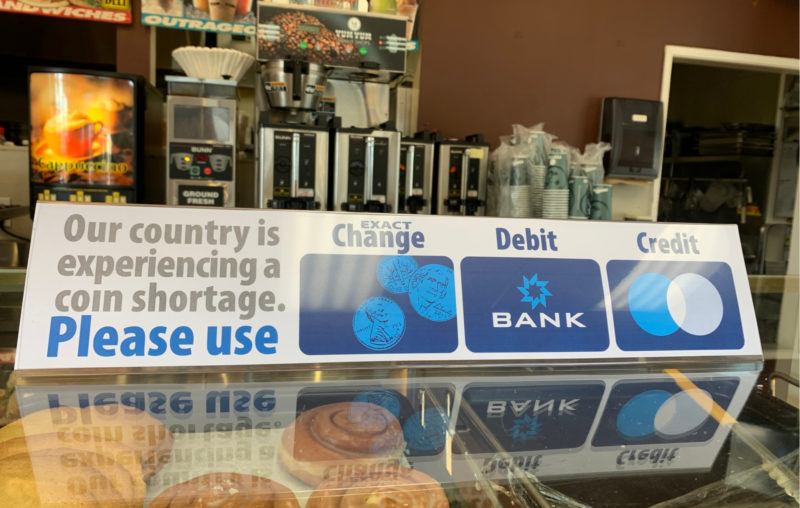
Retailers are asking customers to use credit or debit cards, and some are refusing to make change in coins. They say it’s because of the novel coronavirus. The virus may be playing a part, but,there’s more to the coin shortage.
First, the virus. As we all know, this variant of coronavirus may or may not be transmitted by air, physical contact, surfaces, and there may or may not be other mechanisms. The World Health Organization says that the virus isn’t transmitted on coins or paper money, but who believes them?
With all this uncertainty, people are looking to minimize risk wherever practical. Retailers monitor the number of customers in their stores, and install plexiglass screens between tellers and customers at checkout counters. Once people become concerned about the virus on coins, whether or not this is true, management has to deal with it. Especially if discontinuing using coins saves money.
Handling small change is costly. It requires time of store clerks (as well as time of customers). Then, there is Inventorying and safeguarding currency, and exchanging the mix of denominations accumulated during the day with your banker, for the mix of denominations needed to open the next day.
The cost of pennies is not simply the loss of the U.S. Treasury in producing them (i.e., their cost minus the face value of the pennies produced). It’s the entire cost of producing pennies plus the time spent by people who use the pennies. The first part (cost of production) can be thought of as the explicit cost, and the second part (time cost) the implicit cost. The cost is supposedly warranted because it allows greater precision in pricing goods and services.
However, as with everything else, there is a point of diminishing returns. At some point, the cost of precision comes to be more than the benefit of precision. This balancing of marginal benefit and marginal cost is ubiquitous.
The explicit cost, or the production cost of the penny is about $250 million a year, about two-thirds of which is recovered by the U.S. Treasury in the face value of the coins.
The implicit cost, or time cost, is a bit tougher to calculate. On average, it takes store clerks 2 seconds more to handle a transaction involving pennies. At $15 per hour, this means a transaction involving pennies is 1 cent more costly to process. Considering the number of cash transactions per year, about 80 percent of which involve pennies, the additional cost of transactions due to continued use of the penny is about $250 million a year, or $500 million if the time of the customer is also considered.
Now the question is what is the value of the greater precision gained by the use of pennies?
Precision depends, in part, on the number of digits of precision used in pricing. Are prices going to be stated to the penny or to the nickel? The idea is that prices will continue to be quoted to the penny, and only payments made on the total of cash transactions will be rounded to the nickel. Totals ending in 1 or 2 cents would be rounded down to zero; prices ending in 3 or 4 cents would be rounded up to 5. Totals involving purchases of three or more items appear to be uniformly distributed and, so, both stores and customers should, on average, break even.
Chile and Canada are two countries that have recently retired their lowest denomination coin, adopted the just described rounding convention, and have encountered no problem.
Indeed, pennies have already been partially demonetized in that most vending machines do not accept them.
Consumer advocates fear that individual prices will be rounded up, to the detriment especially. of low-income shoppers. However, this fear misunderstands the point at which rounding occurs. Totals are rounded. Not individual prices. And, the totals are rounded down about as many times as rounded up.
Pennies
The penny currently in circulation represents an attempt to offset the effect of inflation on the 1-cent piece. For a long time, the U.S. government made a meaningful profit minting cents. Then came the inflation of the 1960s and ’70s.
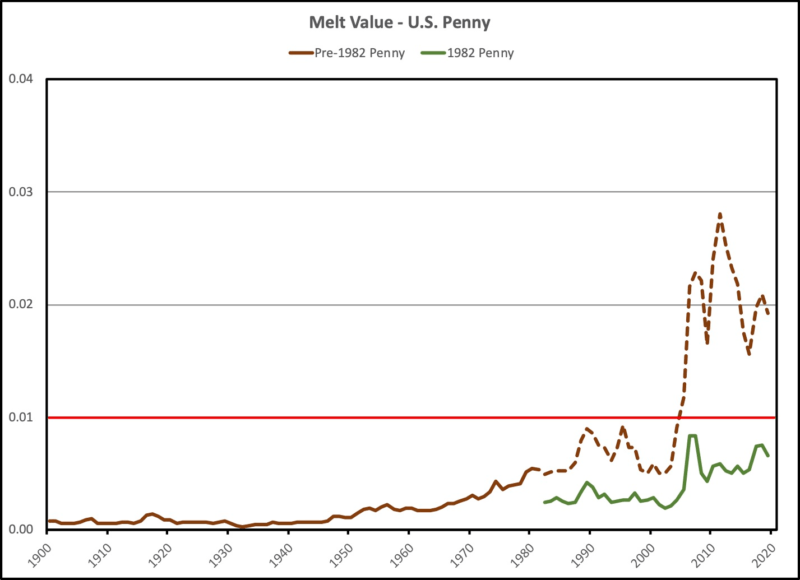
The impact of the inflation of the 1960s and ‘70s is shown in the chart “Melt Value: U.S. Penny.” The value of the copper contained in the pre-1982 cent was a mere fraction of face value. Then, with inflation, that value was rising to an increasingly large fraction. So, in 1982, the government started issuing a new, mostly zinc penny. The new penny is electroplated with copper and is about the same size and weight, so it is evocative of the legacy coin.
Because of the work involved in producing the penny, especially the electroplating, it costs much more to produce than the zinc and copper of which it is composed. The copper electroplated-zinc penny might have made some sense in 1982, but it makes no sense today.
Nickels
The nickel got its name from its distinctive metal. As a five-cent piece, the nickel was introduced in 1866, in a coin having the weight and composition that we still have today.
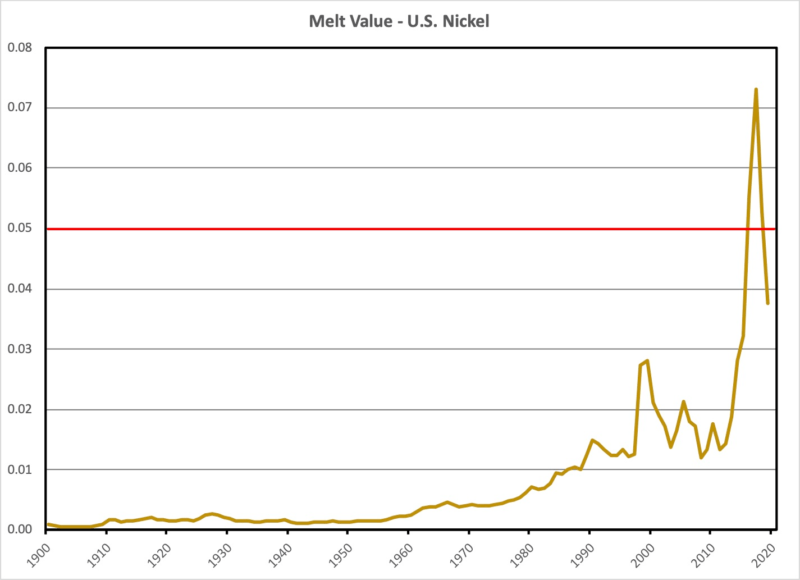
As can be seen in the chart “Melt Value – U.S. Nickel,” this coin was very profitable to produce for a long period of time. Then, the cumulative effect of inflation reduced and eventually eliminated the profit. Even disregarding the work involved in production, the coin briefly became a loser. Taking this work into account, it remains a loser. Only the government can get into the counterfeiting business and lose money.
Nobody is talking of eliminating the five-cent piece. But, there is considerable talk of changing its composition. Several other countries that have or have had nickel coins have reduced or altogether eliminated their nickel content.
Quarters
Quarters (and other silver coins) deserve a bit more discussion. In part, this extended discussion recognizes that the United States was founded as a silver standard country (and only shifted to a gold standard country in 1834).
As can be seen in the chart titled “Melt Value: U.S. Quarter, 19th Century,” the silver quarter was originally worth a quarter. Indeed, it was a quarter, as the half-dollar was a half-dollar, and the dollar was a dollar. Back then, bank notes were mere claims on money (in the sense of legal tender). Bank notes were not themselves money.
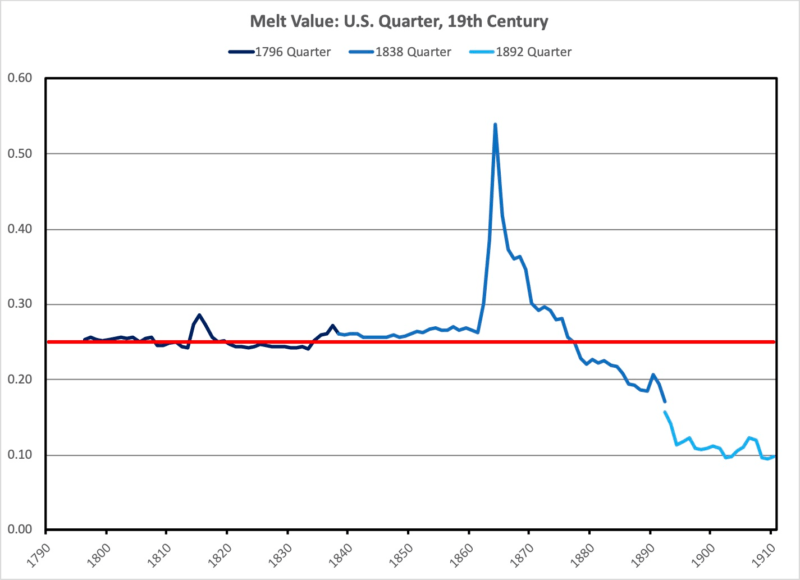
During the War of 1812, there was a suspension of convertibility. Then, in the runup to the Panic of 1837, there was inflation. During this runup, in 1834, the U.S. Dollar was redefined in a way that shifted the U.S. from silver to gold. This shift was associated with Andrew Jackson.
During the troubled times that followed the Panic of 1837, and then the discovery of gold in California, the U.S. had a difficult time with its silver coinage. Full-bodied silver coins tended to disappear from circulation, and there were periodic shortages.
With the enormous inflation associated with the Civil War (in both the Union and the Confederate states), silver coins disappeared completely. They were replaced by a variety of stopgaps, including fractional paper currency.
Following the Civil War, there was a long period of deflation enabling resumption at the prewar parity in 1879. During this time, many countries shifted from silver to gold, and there was a glut of silver in the world. The value of silver fell, especially after the gold standard was secured during the presidency of Grover Cleveland. Silver coins became mere subsidiary coins, meaning they were maintained in value by their limited issue and free convertibility into gold.
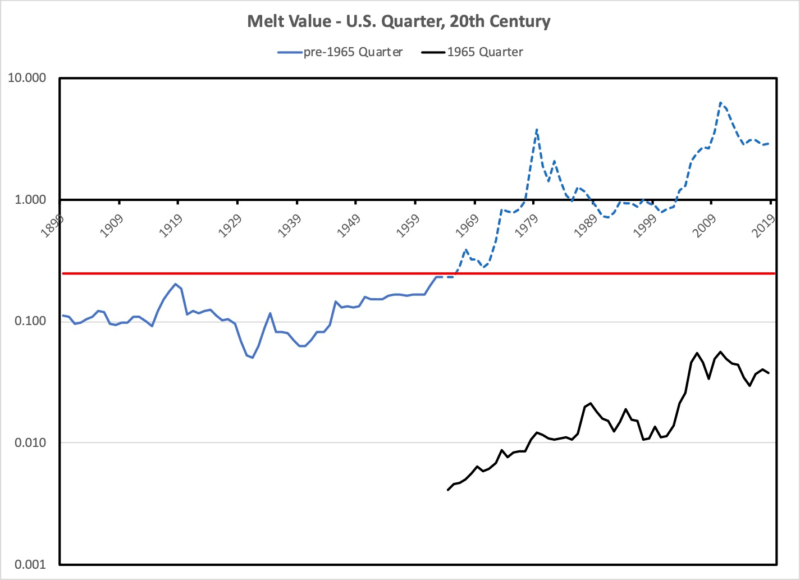
The 20th Century
To track the melt value of the U.S. quarter during the 20th century, it is useful to switch to a logarithmic scale. In this chart, one can see the rise in the value of the quarter associated with World War I, and the fall in this value during the Great Depression. The value of the quarter subsequently recovered and then relapsed. It only permanently recovered following World War II and the Bretton Woods Agreement.
During the inflation of the 1960s and ‘70s, silver jumped in value, and the government quickly replaced the silver quarter with the silver-copper sandwich quarter. The inflation that necessitated this rejiggering of the quarter was just getting started. In 1971, Richard Nixon ended the Bretton Woods Agreement and, in so doing, severed the last link between the dollar and gold. The new sandwich quarter was initially quite profitable to produce but, due to the relentlessness of inflation, its profit margin has been squeezed.
A Summing Up
Through deft use of base metals, the U.S. coinage retains a resemblance to its legacy coinage. But, no matter the electroplating, the reality of inflation cannot be covered over. Our smaller denomination coins cost more to produce than they are worth, and burden our transactions with tedious calculations. Temporarily, due to the virus, some of our businesses are suspending dealing in these coins. Perhaps soon we will replace our coinage with one that makes sense.










